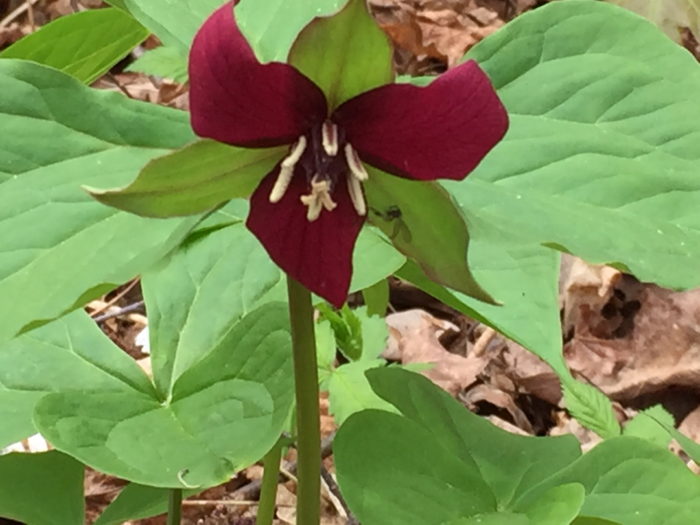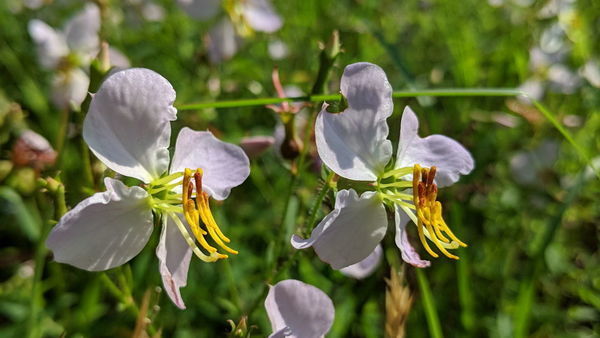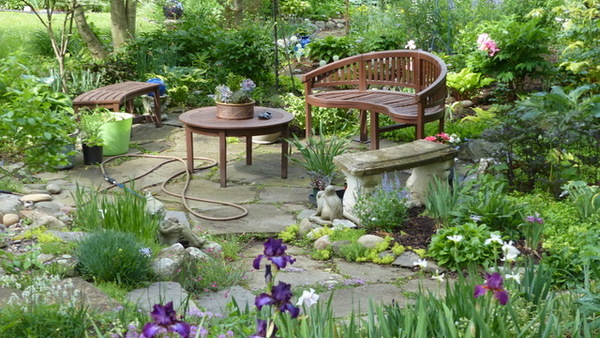
Today’s pictures come from Jayne Spaulding, who sent in these photos of native wildflowers from the White Mountains of New Hampshire (Zone 4). She writes:
With four nor’easters in the month of March, spring here is slow in arriving this year. But anticipation is part of the fun in gardening for me!

Sanguinaria canadensis (bloodroot, Zones 3–9). This little wildflower is common in woodlands over most of the eastern half of North America. These early flowers don’t produce any nectar, so they are pollenated mostly by mining bees in the genus Andrena, which collect the pollen to eat. The name bloodroot comes from the bright orange-red sap in the rhizomes that creep along underground.

Ribes glandulosa (skunk currant, Zones 3–8). This little shrub is primarily found in New England, where it forms these appealing masses of delicate foliage.

Flowers of Ribes glandulosa. These sweet little understated flowers are quite lovely. After blooming, they will develop into ripe fruits with a smell that gives this plant the common name of skunk currant. The fruits are edible and, according to some people, are even quite tasty if picked before they begin developing their typical skunky scent.

Erythronium americanum (dogtooth violet, Zones 3–8). This little wildflower, often referred to as trout lily, is common in woodlands over most of eastern North America. As one of the first native wildflowers to come into bloom, it is a key food source for many native bees and other pollinators that have spent the winter hibernating and need a good meal as the weather warms.

Trillium erectum (red trillium, Zones 3–8). This plant is called trillium because all parts of it come in threes: three leaves, three sepals, three petals. The name erectum comes from the fact that many plants of this species, as seen here, bloom on flowers that are held upright on erect stems over the leaves. Confusingly, however, in some areas, Trillium erectum has flowers that hang down below the leaves and aren’t erect at all. In any case, this is always a dramatic, beautiful plant, with flowers of the darkest possible red.
Have a garden you’d like to share?
Have photos to share? We’d love to see your garden, a particular collection of plants you love, or a wonderful garden you had the chance to visit!
To submit, send 5-10 photos to [email protected] along with some information about the plants in the pictures and where you took the photos. We’d love to hear where you are located, how long you’ve been gardening, successes you are proud of, failures you learned from, hopes for the future, favorite plants, or funny stories from your garden.
If you want to send photos in separate emails to the GPOD email box that is just fine.
Have a mobile phone? Tag your photos on Facebook, Instagram or Twitter with #FineGardening!
You don’t have to be a professional garden photographer – check out our garden photography tips!
Do you receive the GPOD by email yet? Sign up here.





















Comments
Your photos are lovely, Jayne, and highlight a world of plants that I don't know nearly enough about. Have you purchased and planted these woodland treasures or are they growing naturally for you? I love the delicate intricacy of the dogtooth violet...it's so dear.
Thanks for sending these in, Jayne. Spring wildflowers have thrilled me since I was a child; such harbingers of warmth and the end of winter.
Great reminders of what Mother Nature can do on her own. Love seeing these (well some of them) when I get into natural spaces, like the forests where I trail ride...guaranteed to come off my bike for a few moments when my eye catches them. I recently came across a huge "patch" of trout lilies on a recent ride - kinda magical in the stippled sun of the still-thin tree canopy. I really like the layered texture of the skunk currant leaves - definitely not one I see down here. Thanks for sharing.
Your photos are beautiful, Jayne , and take me back to when we would search for trilliums in the WI woods in the spring. Ours were always, white, though. The flowering currant which is in bloom now here in the PNW has the same leaf but a much different flower. Thanks for sharing.
Jayne it is lovely to see your photos as a reminder of happiness and joy to come.
- Lily from Hooksett
All beautiful! That trillium is an amazing color. Thank for sharing.
Thank you for such clear closeup pictures of the bounty on the forest floor. I feel like I've had a spring walk in the woods.
Jayne, thank you for sharing these lovely photos of nature's ephemerals! I love them all, and am so happy to hear from others that there are areas where they still grow in quantity. Our Ozark trillium is up now, but not blooming yet, the blood root is already gone. Is anybody growing shooting star or dutchman's breeches?
Log in or create an account to post a comment.
Sign up Log in